Standard ISO 834
The Standard temperature-time curve ISO 834, also known as the Cellulosic curve and/or the standard nominal fire curve, is used to test the fire resistance of materials subjected to a category "A" fire hazard i.e. with the fire hazard rating based on the burning rate of general combustible building materials and building contents. The ISO 834 is the least "intensive" of the fire curves.
Previous tests on intumescent materials, using the bench-scale cone calorimeter to simulate the ISO 834 curve, imposed a constant radiant heat flux as per ISO5660 (Mesquita, 2009). The ISO 834 curve below represents a fully developed fire in a compartment and shows that temperature increases with time at a constant rate. Within this research study it is intended to test Intumescent coatings, using a bench-scale cone calorimeter and the fire propagation apparatus, by developing a more accurate ISO 834 radiant heat flux curve. The radiant heat flux imposed on the samples will be numerically analysed and calibrated to simulate the ISO 834 curve. This will differ from previous tests, in that the applied heat flux will vary with time during the test i.e. irradiance will not be contant
ISO 834-8:2002 Fire Resistance Tests – Elements of building construction
The standard temperature-time curve is defined by the following expression:
T = To + 345log10 (8t+1)
Where,
t is time (min)
T is the furnace temperature (°C) at time t
To is the initial furnace temperature (°C)
Previous tests on intumescent materials, using the bench-scale cone calorimeter to simulate the ISO 834 curve, imposed a constant radiant heat flux as per ISO5660 (Mesquita, 2009). The ISO 834 curve below represents a fully developed fire in a compartment and shows that temperature increases with time at a constant rate. Within this research study it is intended to test Intumescent coatings, using a bench-scale cone calorimeter and the fire propagation apparatus, by developing a more accurate ISO 834 radiant heat flux curve. The radiant heat flux imposed on the samples will be numerically analysed and calibrated to simulate the ISO 834 curve. This will differ from previous tests, in that the applied heat flux will vary with time during the test i.e. irradiance will not be contant
ISO 834-8:2002 Fire Resistance Tests – Elements of building construction
The standard temperature-time curve is defined by the following expression:
T = To + 345log10 (8t+1)
Where,
t is time (min)
T is the furnace temperature (°C) at time t
To is the initial furnace temperature (°C)

